What Is the Difference Between an Abbreviation and an Acronym?
An abbreviation and an acronym are both shortened versions of something else. Both can often be represented as a series of letters. Many people are unable to tell the difference between an abbreviation and an acronym.
Abbreviation vs. Acronym
There is a great deal of overlap between abbreviations and acronyms. Every acronym is an abbreviation because the acronym is a shortened form of a word or phrase. However, not every abbreviation is an acronym, since some abbreviations – those made from words – are not new words formed from the first few letters of a series of words.
Abbreviation
An abbreviation is a shortened form of a word or phrase, as N.Y. for New York, Mr. for Mister, lb for pound or ctn for carton.
There are millions of common abbreviations used every day.
- When you write out your address, most people write “St. or Ave.” instead of “street” or “avenue.”
- When you write the date, you may abbreviate both the day of the week (Mon, Tues., Wed., Thurs., Fri., Sat., and Sun.) and the month of the year (Jan., Feb., Aug., Sept., Oct., Nov., Dec.).
- There are also tons of industry specific abbreviations that you may be unaware of unless you are in the industry, such as medical abbreviations or dental abbreviations.
Shortening the word “Avenue” to “Ave.” is an abbreviation, because it is the shortened version of the word. However, it is not an acronym since the word AVE is not a new word comprised of the first few letters of a phrase.
Acronym
An acronym, technically, must spell out another word. However, this rule isn’t always rigidly enforced:
- ASAP is an acronym although the word “asap” is not in many dictionaries. Still, the first letters of each of the words “As Soon As Possible” are used to form the acronym ASAP.
- NY is the acronym for New York. Since this acronym is a shortened version of the phrase, by definition the acronym is also an abbreviation.
Like abbreviations, acronyms are used daily, and most people can interpret the meaning of common acroynmswithout much thought. For example:
- You go to the ATM instead of to the automatic teller machine
- You give your time zone as EST, CST or PST instead of as Eastern Standard Time, Central Standard Time or Pacific Standard Time.
- You use words like BRB (be right back), LOL (laughing out loud), and ROFL (rolling on floor laughing) when texting. These new acronyms were derived from computer lingo. All of these new acronyms are also abbreviations because they are all shortened versions of phrases that IM-ers were using frequently. For more information read our Guide to Internet Abbreviations.
Abbreviations
According to Dictionary.com, an abbreviation is a shortened or contracted form of a word or phrase, used to represent the whole, as Dr. for Doctor, U.S. for United States, lb. for pound.
Initialisms and acronyms are two types of abbreviations that are used to shorten phrases.
Initialisms are abbreviations that are pronounced one letter at a time.
Examples:
– FBI
– HTML
– IBM
– DVD
– BTW (by the way)
Note that most people would simply call these abbreviations, which is fine. Some would call them acronyms, which sticklers would challenge.
Acronyms are abbreviations that are pronounced as words.
Examples:
– NATO (North Atlantic Treaty Organization)
– AIDS (Acquired Immune Deficiency Syndrome)
– OPEC (Organization of the Petroleum Exporting Countries)
– SPA (Society of Professional Accountants)
– WASP (White Anglo-Saxon Protestant)
– ASAP (as soon as possible)
– Radar (radio detecting and ranging)
– Scuba (self-contained underwater breathing apparatus)

